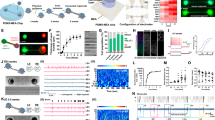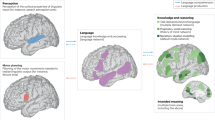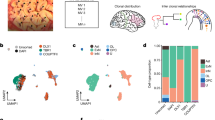Abstract
The arcuate fasciculus is a white-matter fiber tract that is involved in human language. Here we compared cortical connectivity in humans, chimpanzees and macaques (Macaca mulatta) and found a prominent temporal lobe projection of the human arcuate fasciculus that is much smaller or absent in nonhuman primates. This human specialization may be relevant to the evolution of language.
This is a preview of subscription content, access via your institution
Access options
Subscribe to this journal
Receive 12 print issues and online access
$209.00 per year
only $17.42 per issue
Buy this article
- Purchase on Springer Link
- Instant access to full article PDF
Prices may be subject to local taxes which are calculated during checkout



Similar content being viewed by others
References
Geschwind, N. Science 170, 940–944 (1970).
Dejerine, J. Anatomie des Centres Nerveux (Rueff et Cie, Paris, 1895).
Glasser, M.F. & Rilling, J.K. Cereb. Cortex published online, doi:10.1093/cercor/bhn011 (14 February 2008).
Powell, H.W. et al. Neuroimage 32, 388–399 (2006).
Petrides, M. & Pandya, D.N. in Principles of Frontal Lobe Function (eds. Stuss, D.T. & Knight, R.T.) 31–50 (Oxford University Press, New York, 2002).
Behrens, T.E., Berg, H.J., Jbabdi, S., Rushworth, M.F. & Woolrich, M.W. Neuroimage 34, 144–155 (2007).
Croxson, P.L. et al. J. Neurosci. 25, 8854–8866 (2005).
Price, C.J. J. Anat. 197, 335–359 (2000).
Sakai, K.L. Science 310, 815–819 (2005).
Rilling, J.K. & Seligman, R.A. J. Hum. Evol. 42, 505–533 (2002).
Preuss, T.M. in The Cognitive Neurosciences 3rd edn. (ed. Gazzaniga, M.S.) 5–22 (MIT Press, Cambridge, Massachusetts, 2004).
Deacon, T. The Symbolic Species (W.W. Norton, New York, 1997).
Schoenemann, P.T., Sheehan, M.J. & Glotzer, L.D. Nat. Neurosci. 8, 242–252 (2005).
Gould, S.J. J. Soc. Issues 47, 43–65 (1991).
Johnson-Frey, S.H., Newman-Norlund, R. & Grafton, S.T. Cereb. Cortex 15, 681–695 (2005).
Acknowledgements
We thank Q. Shen and F. Zhao for technical assistance, and M.F.S. Rushworth and M.J. Konner for many helpful comments. We also thank P. Croxson for collecting the human scans and M.-M. Carrasco for assistance with tracking control pathways. This work was supported by the Center for Behavioral Neuroscience Science and Technology Center Program of the National Science Foundation under agreement no. IBN-9876754, Emory University Research Committee, James S. McDonnell Foundation grant 21002093 to T.M.P., RO1EB002009 to X.H., the Yerkes Base Grant (NIH RR-00165) and the UK Medical Research Council to T.E.J.B.
Author information
Authors and Affiliations
Contributions
J.K.R. designed the study, acquired the nonhuman data, supervised analyses and wrote the paper. M.F.G. analyzed the data. T.M.P. acquired the nonhuman brains, assisted with data analysis and presentation, and wrote the paper. X.M., T.Z. and X.H. assisted with nonhuman primate protocol development, and T.E.J.B. and Oxford colleagues acquired the human data. T.E.J.B. oversaw the data-analysis strategy with the exception of the in vivo chimpanzee and macaque data presented in the supplementary information.
Corresponding author
Supplementary information
Supplementary Text and Figures
Supplementary Figures 1–4, Table 1 and Methods (PDF 700 kb)
Rights and permissions
About this article
Cite this article
Rilling, J., Glasser, M., Preuss, T. et al. The evolution of the arcuate fasciculus revealed with comparative DTI. Nat Neurosci 11, 426–428 (2008). https://doi.org/10.1038/nn2072
Received:
Accepted:
Published:
Issue Date:
DOI: https://doi.org/10.1038/nn2072
This article is cited by
-
Generalising XTRACT tractography protocols across common macaque brain templates
Brain Structure and Function (2024)
-
Language evolution and computational capabilities: conceptualization of the first language units
International Journal of Anthropology and Ethnology (2023)
-
Breakdown of category-specific word representations in a brain-constrained neurocomputational model of semantic dementia
Scientific Reports (2023)
-
Bayesian stroke modeling details sex biases in the white matter substrates of aphasia
Communications Biology (2023)
-
A map of white matter tracts in a lesser ape, the lar gibbon
Brain Structure and Function (2023)



